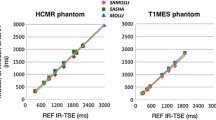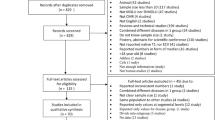Abstract
Cardiac Magnetic Resonance (CMR) is increasingly being used for diagnosing various cardiac conditions. Parametric mapping enables quantitative myocardial characterization by directly measuring myocardial T1 and T2 values. However, reference values of parametric mapping are not standardized across different vendors and scanners, causing drawbacks for clinical implementation of this technique across different sites. We assessed the reference ranges of native T1 and T2 values in a healthy Maltese cohort to establish a local parametric mapping service. Healthy subjects [n = 51; mean age 36.0 (range 19–59) years] with normal cardiac function on CMR were recruited. Subjects underwent uniform parametric mapping pulse sequences [MOLLI 5b(3b)3b for native T1 mapping, and gradient echo single shot FLASH readout for T2 mapping] on a 3 T Siemens MAGNETOM Vida scanner. Native T1 and T2 values were measured by placing a region of interest within the interventricular septum at midventricular level. Intra- and inter-observer variability were assessed using Bland–Altman plots. Mean ± 1.96 SD was used as a reference range. Mean native T1 and T2 values were 1200.1 ± 30.7 ms and 39.5 ± 1.8 ms, respectively. There was no significant bias in repeated measurements by the same and different observers. For the first time in Malta, we established the native T1 and T2 parametric mapping reference values for healthy Caucasian Maltese individuals. This will assist cardiologists to establish diagnosis, disease progression, and response to treatment of various myocardial diseases locally.





Similar content being viewed by others
Data availability
Above listed authors take responsibility for all aspects of the reliability and freedom from bias of the data presented and their discussed interpretation.This work has not been presented elsewhere.
References
Situ Y, Birch SCM, Moreyra C, Holloway CJ (2020) Cardiovascular magnetic resonance imaging for structural heart disease. Cardiovasc Diagn Ther 10(2):361–375. https://doi.org/10.21037/cdt.2019.06.02
Ferreira VM, Piechnik SK (2020) CMR parametric mapping as a tool for myocardial tissue characterization. Korean Circ J 50(8):658–676. https://doi.org/10.4070/kcj.2020.0157
Mewton N, Liu CY, Croisille P, Bluemke D, Lima JAC (2011) Assessment of myocardial fibrosis with cardiovascular magnetic resonance. J Am Coll Cardiol 57(8):891–903. https://doi.org/10.1016/j.jacc.2010.11.013
Messroghli DR, Moon JC, Ferreira VM et al (2017) Clinical recommendations for cardiovascular magnetic resonance mapping of T1, T2, T2* and extracellular volume: a consensus statement by the Society for Cardiovascular Magnetic Resonance (SCMR) endorsed by the European Association for Cardiovascular Imagi. J Cardiovasc Magn Reson 19(1):75. https://doi.org/10.1186/s12968-017-0389-8
Higgins DM, Keeble C, Juli C, Dawson DK, Waterton JC (2019) Reference range determination for imaging biomarkers: myocardial T(1). J Magn Reson Imaging 50(3):771–778. https://doi.org/10.1002/jmri.26683
Pons-Lladó G (2019) Reference normal values for myocardial T1 and T2 maps with the MAGNETOM Vida 3T system and case examples from clinical practice. MAGNETOM Flash 72:29–33
Teixeira T, Hafyane T, Stikov N, Akdeniz C, Greiser A, Friedrich MG (2016) Comparison of different cardiovascular magnetic resonance sequences for native myocardial T1 mapping at 3T. J Cardiovasc Magn Reson 18(1):65. https://doi.org/10.1186/s12968-016-0286-6
Dong Y, Yang D, Han Y et al (2018) Age and gender impact the measurement of myocardial interstitial fibrosis in a healthy adult chinese population: a cardiac magnetic resonance study. Front Physiol. https://doi.org/10.3389/fphys.2018.00140
Lee E, Kim PK, Choi BW, Jung JI (2020) Phantom-validated reference values of myocardial mapping and extracellular volume at 3T in healthy koreans. Investig Magn Reson Imaging 24(3):141–153. https://doi.org/10.13104/imri.2020.24.3.141
Roy C, Slimani A, de Meester C et al (2017) Age and sex corrected normal reference values of T1, T2 T2* and ECV in healthy subjects at 3T CMR. J Cardiovasc Magn Reson 19(1):72. https://doi.org/10.1186/s12968-017-0371-5
Tribuna L, Oliveira PB, Iruela A, Marques J, Santos P, Teixeira T (2021) Reference values of native T1 at 3T cardiac magnetic resonance-standardization considerations between different vendors. Diagnostics. https://doi.org/10.3390/diagnostics11122334
Kellman P, Hansen MS (2014) T1-mapping in the heart: accuracy and precision. J Cardiovasc Magn Reson 16(1):2. https://doi.org/10.1186/1532-429X-16-2
Granitz M, Motloch LJ, Granitz C et al (2019) Comparison of native myocardial T1 and T2 mapping at 1.5T and 3T in healthy volunteers. Wien Klin Wochenschr 131(7):143–155. https://doi.org/10.1007/s00508-018-1411-3
Baeßler B, Schaarschmidt F, Stehning C, Schnackenburg B, Maintz D, Bunck AC (2015) A systematic evaluation of three different cardiac T2-mapping sequences at 1.5 and 3T in healthy volunteers. Eur J Radiol 84(11):2161–2170. https://doi.org/10.1016/j.ejrad.2015.08.002
Funding
The authors received no financial support for the research authorship, and/or publication of this article.
Author information
Authors and Affiliations
Contributions
K.Y. and L.M.Y. organized a whole study, wrote the main manuscript text and prepared figures and tables. M.A. and A.B. contributed in statistical analysis and reviewed the main manuscript text. C.P.M. and L.M. collected data. L.R. helped recruiting subjects.
Corresponding author
Ethics declarations
Competing interests
The authors declare no competing interests.
Conflict of interest
The authors declared no potential conflicts of interest with respect to the research, authorship, and/or publication of this article.
Additional information
Publisher's Note
Springer Nature remains neutral with regard to jurisdictional claims in published maps and institutional affiliations.
Rights and permissions
Springer Nature or its licensor holds exclusive rights to this article under a publishing agreement with the author(s) or other rightsholder(s); author self-archiving of the accepted manuscript version of this article is solely governed by the terms of such publishing agreement and applicable law.
About this article
Cite this article
Yamagata, K., Yamagata, L.M., Abela, M. et al. Native T1 and T2 reference values for maltese healthy cohort. Int J Cardiovasc Imaging 39, 153–159 (2023). https://doi.org/10.1007/s10554-022-02709-6
Received:
Accepted:
Published:
Issue Date:
DOI: https://doi.org/10.1007/s10554-022-02709-6




